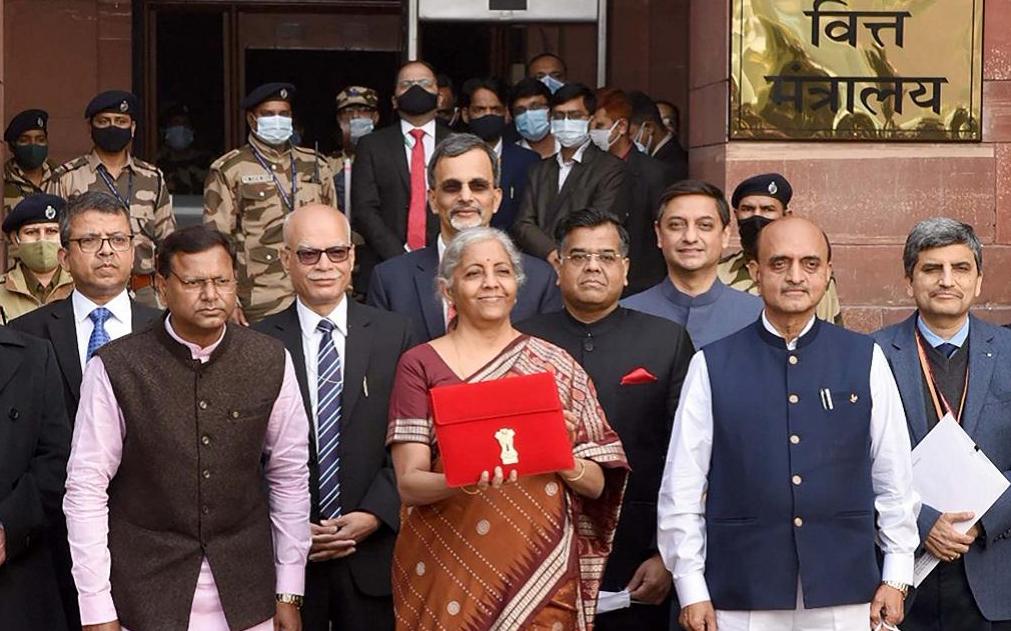Santosh Kumar Mohapatra
The Union Budget presented by Finance Minister Nirmala Sitharaman for 2022-23 has evoked mixed reactions. A Budget is not evaluated in terms of schemes or some allocations only as revenues and outlay increase every year and any finance minister can have some schemes. A Budget can be called expansionary if projection of GDP is correct and the increase in budgetary outlay is higher than projected nominal GDP growth.
Sitharaman has prepared the Budget with assumption that real GDP will grow by 8 to 8.5% while nominal GDP by 11.1% to touch `258 lakh crore. However, the budgeted total expenditure is projected to be `39.45 lakh crore, which is not only lesser than projected nominal GDP growth but amounts to slashing expenditure in real terms (taking inflation into account). The total budgetary outlay for 2021-22 which was estimated to be `34.83 lakh has increased to `37.70 lakh crore in the revised estimate. However, the growth projection is made with assumptions that the situation will be normal. But normal situation is rarely feasible.
Further, the budgetary outlay of India as a percentage of GDP is shrinking and much lower than many countries. By December 2020, the government expenditure as a percentage of GDP in India was 18.4%, much lower than France at 62.1%, Norway 58.4%, Eurozone 54.1%, Sweden 52.6%, the UK 52%, Belgium 60%, Italy 57.3%, Germany 51.1%, the US 44%, and Japan 38.7%. What is worrying is that as a percentage of GDP the total expenditure has come down from 17.7% in 2020-21 to 16.2% in 2021-22 and is estimated to decline further to 15.3% in 2022-23. This establishes that the Budget is contractionary.
India has the ignominy of having the highest number of hungry and poor people in the world. Hence, subsidy to poor and farmers is an integral part of any Budget to help the vulnerable sections and ensure distributive justice. But, while the present government is consistent in giving huge concession to corporates and the rich, it harbours disdain for the poor and farmers which is reflected through the reduction of subsidies. The fertilizer subsidy has been reduced by 25% to `1,05,222 crore in 2022-23 from `1,40,112 in the previous fiscal. The food subsidy has been reduced to `2,06,481 crore from `2,86,219 crore. The fuel subsidy, which was `38,256 crore in 2019-20, has been gradually reduced to `5,812.5 crore.
By contrast, due to more concessions, reduction of corporate tax in past, the effective corporate tax has been reduced to 22.54% in 2019-20 from 27.81% in 2018-19. In this Budget, corporate surcharge have been reduced from 12% to 7%.
The Budget assumes that the present economic malaise is triggered by supply-side constraints. Actually, the problem is on the demand side. The household spending measured through private final consumption expenditure is still 3% below the pre-pandemic level. The grim reality is that due to draconian demonetisation and flawed GST, the economy has slowed down with demand receding. The pandemic has just exacerbated the situation, corroding purchasing power of people and squeezing demand.
The Budget comes at a time when the economy has assumed the dangerous K-shape of recovery with the rich getting richer and the poor getting poorer. While stock market is booming, real economy is crumbling. The GDP for 201-22 is only 1.3% higher than the pre-pandemic level and last two years have been wasted fully with people being beleaguered by excruciating experience of pandemic. Poor Indians saw erosion of their purchasing power and demand due to unprecedented rise of prices of essential commodities. While the Economic Survey ignored this stating that it was imported inflation, the Budget failed to address the problem.
The finance minister had a golden opportunity to address these problems by presenting a progressive Budget and change our regressive tax system. But she presented a regressive Budget by relying more on indirect taxes, making the lives of poor more miserable as indirect taxes are paid by the rich and the poor at the same rate.
Despite boasting of higher GST, projected tax revenue growth is only 9.6%, which is less than projected nominal GDP growth. The Centre’s gross tax-GDP ratio, which is one of the lowest in world, is expected to decline to 10.7% in 2022-23 from 10.8% in 2021-22. The Centre’s debt as proportion of GDP is likely to cross 60% as against the target of 40% prescribed by IMF.
When enhancement of capital expenditure by 35% is celebrated, nobody tells that as many as 439 infrastructure projects, each entailing investment of `150 crore or more, have been hit by cost overruns totalling more than `4.38 lakh crore. It is said that the Budget opted for lasting benefits not temporary relief. The finance minister also stated that the Budget gives a blueprint of the economy from India at 75 to India at 100. She further said that the Budget for the next fiscal “will focus on Amrit Kaal.” But in the long run, everybody is dead. When it is difficult for large section of Indians to survive today, how can they dream of future?
The writer is an Odisha-based economist and
columnist. Views are personal.
